90+ Pounds Lighter
The first thing I did after I came home from my college graduation was hibernate sleep for 17 hours straight. Perhaps in honor graduating as a part of the Class of 2017?
The second thing I did was clean. I have been interested in learning more about the zero-waste movement, minimalism, alternative living styles, etc. It’s made me think about physical gift giving, buying in bulk, agriculture, fast fashion, our planet, my consumption levels, and how they’re all connected.
How I could apply this to my own life? What could I recycle? Give up? Throw out? Pass on?
As if my mom was reading my mind, the first thing she tells me when I come home from college:
“Tay, anything you keep will be coming with you when you move to your new job at the end of the summer.”
Well, that placed a timer on my plans…
Table of Contents
My Summer Goal: Fit all (or as much as possible) of my stuff into one carload of space.
My plan is to continue to donate and recycle out clothes and my belongings until I officially move out of the house in approximately 3.5 months.
This is only Phase 1!
Initially, I wanted to create a capsule wardrobe, where I choose 30-40 staple pieces of clothing that I could mix and match to wear in the warmer summer season. The rest, I would simple recycle. Easy!
But because I had never deliberately inventoried my closet before, I severely underestimated how many clothes I owned…
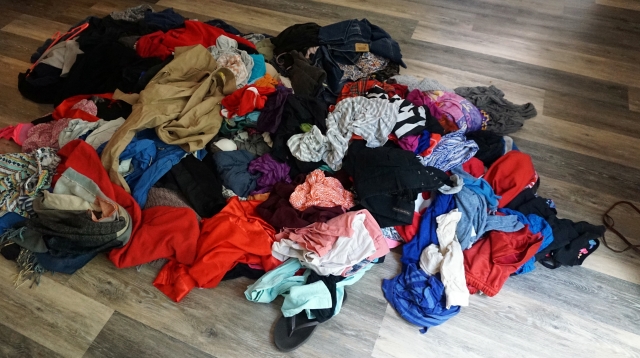
Step 1: Fold* and sort my closet into roughly the following categories:
- T-Shirts
- Long sleeves / sweaters
- Sweatshirts and jackets
- Jeans, pants, leggings, sweatpants
- Skirts and dresses
- Socks and underwear
- Shoes
- Accessories (scarfs, belts, bags)
- Seasonal clothes
*I figured, if I cared about the clothes enough, I should fold them too.
Step 2: Say goodbye
After everything was laid out, I immediately removed 17 shirts from my closet for good.
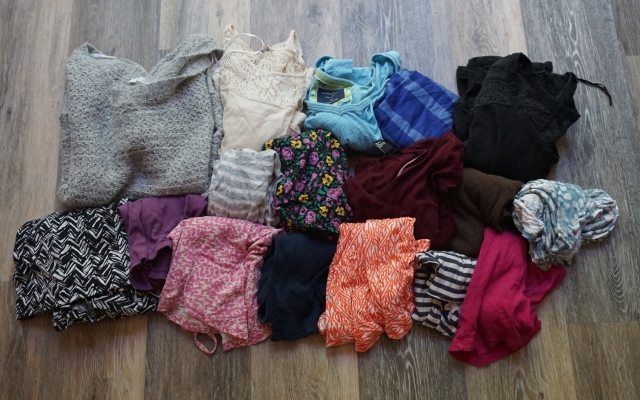
How did you make your decisions?
I asked myself…
- Does it fit… perfectly? Remember Taylor, you already have perfectly fitting and comfy clothes in your closet.
- Is it in good shape? Are there holes? Stains? Faded colors?
- When was the last time this was worn? Two years ago? Never?
- Will I be compelled to wear this in the near future, especially if it hasn’t been worn recently?
- Does it fit with the style of clothes I hope to wear in the future?
Many clothes were easily eliminated from the first three criteria. Some decisions were a bit more difficult. For instance, ever since high school, I’ve been really into solid colored shirts. I’ve accumulated quite a bit since then (left) and ended up keeping 7/13 of the bunch (right).
I know I don’t need all of them, but this was the best I could do in that moment. Remember this is only Phase 1! Progress looks different to each person.
Step 2*: Keep Saying Goodbye – Be Thorough!
I scoured my closets, drawers, and the attic. I even extended the search to non-clothing items and targeted a lot of the “low-hanging fruit”:
- Decorations
- Accessories
- Makeup
- Electronics
- Clothes and shoes
- Letters, birthday cards*, old receipts, magazines, books
- Containers
- Anything that is broken…
*Before I recycled some stuff, I took pictures of some of my old letters and birthday cards, and sent them to friends. It was nice to see their reaction, but I am glad they’re no longer collecting dust in my closet. Their lukewarm or polite reactions reminded me that a friendship can’t be contained by a piece of paper.
As the pile grew larger and larger, it was satisfying to see the progress:
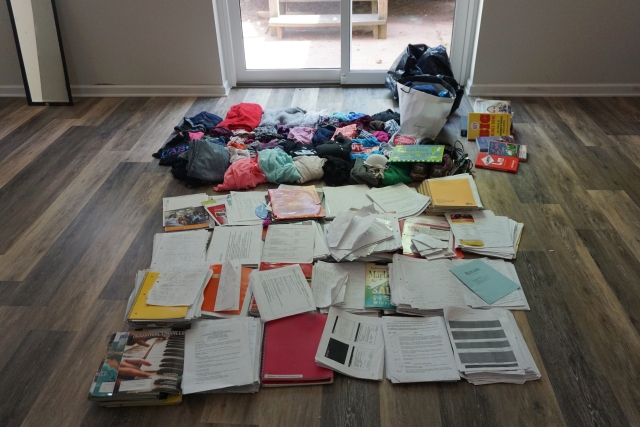
I also ended up recycling 90 pounds of paper. Special shoutout to engineering for contributing to the most of that weight.
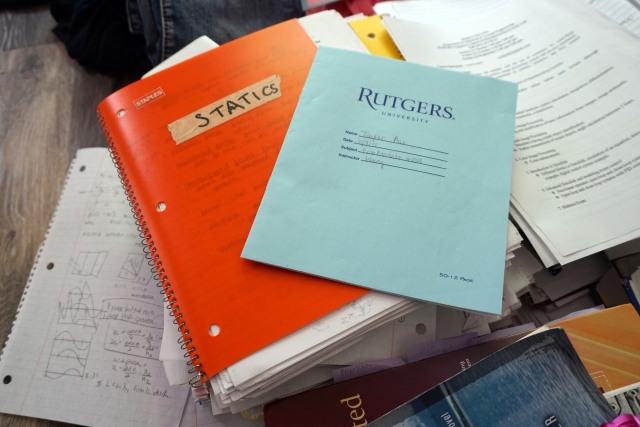
Step 3: Remove it from your space
After I looked at the amount of stuff (filled with memories and meaning) I had amassed, I then made the decision to let it all go:
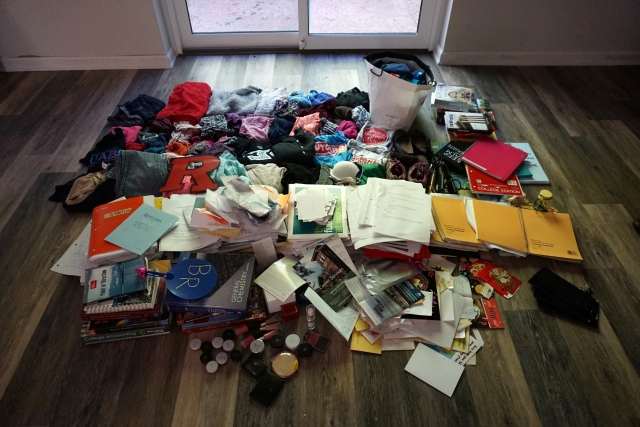
Everything went to the following places:
- Straight to the garbage if it couldn’t be recycled (like old makeup and broken toys)
- Recycling (especially the 90+ pounds of paper)
- Goodwill / Thrift shops (if the clothes and items were still in good condition)
- Family and friends (if I thought they could appreciate it, especially the books)
Step 4: Repeat?
I am a fairly sentimental person. I like being surrounded by stuff with significance. It feels cozy, comfortable, and inspiring.
But taking away all of this stuff did not necessarily lower my quality of living. It did not affect my happiness levels or hurt my social status (!) either.
To be honest, having less doesn’t feel too different from having more.
It feels really good to know that I am closer to the amount of items I actually use and love regularly. It is a relief to know that I can bring less with me when I move away.
If anything, it leaves room for the new memories to come.
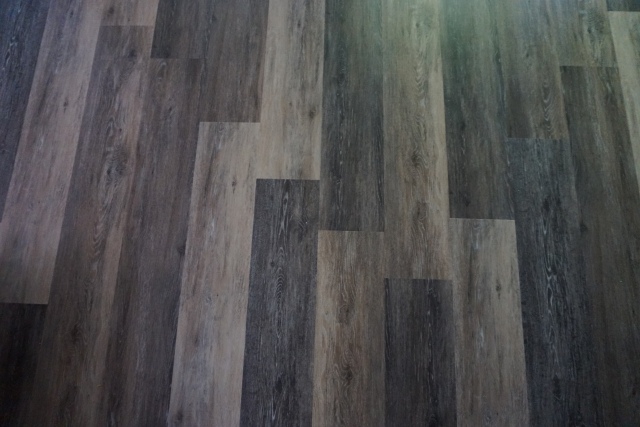
Moving forward, here are some things that I will keep in mind:
1. Not everything needs to be physically possessed (by me) in order to be appreciated.
2. Only buy what you need, if and WHEN you need it – Anticipatory shopping or shopping for the stuff you think you need in the future, has proven to create more clutter than help in the long run. I used to buy in advance, especially with items like shampoo and food. Many times, I’d forget these items exist or the expiration date would arrive before I used the item, which is a waste in itself. Sometimes it worth it to cross the bridge when you arrive, rather than stock up for the future.
3. Invest in higher quality products that can stay with you longer.
4. It’s okay to have some empty space in your life – An empty day on your calendar can feel unproductive or inadequate, but rest days are crucial too. It allows you to relax and recharge. Having this space can increase your flexibility. It can allow fresh ideas, thoughts, people, and memory to enter your life potentially for the better.
Sometimes, less can feel more whole than more.
